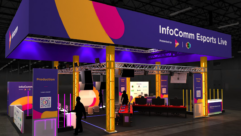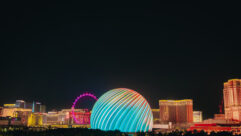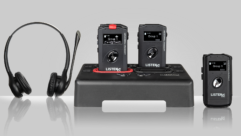Parallax View: Infocomm 2007
The pro AV channel, which had taken a backseat to the consumer channel in terms of manufacturer interest, is suddenly ?hot? again.
INFOCOMM 2007, held at the Anaheim Convention Center, in Anaheim, Calif., clearly showed that display and interface manufacturers have rediscovered gold in the hills of Southern California. While profitability has taken a beating as HDTV set manufacturers fight for consumer market share, things are a bit more stable in the pro/commercial channel.
That’s because so many pro products are sold as part of an installation, not as stand-alone products for “plug and play” end users. (You want a hang and bang projector? Go to Staples!) And the industry is also in the midst of a transition to digital signal transmission and interfacing.
Throw in HDTV, digital signage, and IT/AV crossover products, and you’ve got the makings of a bang-up show that had full aisles for all three days. In addition, the InfoComm Education program was in full swing with more than a hundred classes, and peripheral events like EduComm and the Projection Summit had their own crowds.
I couldn’t spend nearly as much time at the show as I wished. Still, I did make it to a few press events and saw some interesting products. Here are a few highlights:
3LCD: The LCD projector camp has been taking it on the chin from Texas Instruments for several years. First, there was TI’s “questionable” projector reliability study, followed by a more scientific version. Then, TI began trumpeting higher resolution, smaller chips, and Brilliant Color, which is apparently going to be a standard feature on most single-chip DLP projectors shortly.
However, the DLP camp was largely caught off-guard last fall by a wave of affordable, high-performance three-panel LCD and LCoS projectors, all of which sported 1920×1080 resolution and were free of the “rainbow” artifact. And the 3LCD group, which started out as a half-hearted attempt to promote the technology, now has a serious focus and message.
Karl Lang’s research on the advantages of three-panel color versus sequential color imaging, presented at the 3LCD press dinner, was quite revealing and an eye-opener for anyone who thinks LCD projectors are old hat. Check out the 3LCD Web site at www.3lcd.com.
Sanyo: They held their first-ever press conference at InfoComm and had some cool products to boot, including the world’s shortest-throw projection system (PLC-XL50N, claimed to form an 80-inch image from a distance of 3 inches), a new 1920×1080 large venue projector, and support for the 1280×800 notebook computer display standard.
Sanyo also showed an automatic filter maintenance system (as did Panasonic) and a demo of high-bandwidth wireless HD using Amimon’s interface. And they’ve expanded networking into a broad range of their products.
Mersive: This Lexington, Ky.–based company showed an impressive seamless blending/tiled widescreen display system that used 27 projectors. Their software and hardware provides automatic edge registration and feathering through a special camera, making setup a snap (literally).
Mitsubishi: The folks from Irvine, Calif., had a QFHD (3840×2160) resolution 56-inch LCD monitor, suitable for high-resolution static imaging. The 56P-QF60LCU will sell for $49,995 and had excellent contrast and color saturation. In another part of their booth, the HC4900 was unveiled. It’s a $2,995, 1080p home theater projector (3LCD) with DVI and HDMI inputs and dynamic iris control.
JVC: If you like the company’s 2K projectors, the 4K will definitely be your cup of tea. JVC’s 4K demo included HD video, film transfers, and still images. It uses a new 1.27-inch D-ILA panel with 4096×2400 pixel resolution. No price yet on a projector chassis — the demo was just so show a compact 4K projector can be built.
Panasonic: Last year, Panasonic spun off its projector business into a separate company, and followed suit with their plasma business, now known as Panasonic Professional Displays. Both companies shared a large booth at the show and offered a wide range of products, from a 10,000-lumen water-cooled DLP design to the PT-FW100NTU, a new desktop LCD projector with 1280×800 resolution that has the automatic filter system.
Parallax View: Infocomm 2007
The pro AV channel, which had taken a backseat to the consumer channel in terms of manufacturer interest, is suddenly ?hot? again.
FEEDBACK
RGB Spectrum: An 8×8 DVI switcher product is nothing special, but the cables connected to it were. RGB Spectrum’s XtendView hybrid cables contain DVI-to-fiber transitions, built into the plugs. They come in 15, 30, 50, and 100-meter lengths. No cables to trim, no connectors to mount and seal, but all the benefits of wideband fiber — at least for the red, green, and blue channels. Sync travels on separate copper lines.
Samsung: You’ve probably heard this before, but their 82-inch LCD monitor is now a commercial product (820DXN) and should be shipping any day now. (Hmm, it’s déjà vu all over again!) Samsung also showed 42-inch, 46-inch, and 52-inch commercial 1080p LCD monitors and the XL20/XL30-series computer monitors with LED backlights. (Those colors really popped!)
Barco: The iCon 250 made its appearance in Anaheim. It’s a smaller version of the iCon 600, a full 1920×1080 front projector rated at 2500 lumens and designed for smaller conference spaces. There’s also an iCon 400, rated at 4000 lumens. More manufacturers are jumping on the 1080p conference room projector bandwagon, but Barco was one of the first to serve this growing market.
Sharp: They showed the XG-PG610X, a super-compact three-chip DLP projector with UHP lamps — and 1024×768 resolution? Conversations with Sharp executives included emphatic suggestions to kill off the XGA product immediately and instead shift to SXGA+ (1400×1050) and 1920×1080 resolution, where there would be little competition. Great design, wonderful execution, wrong resolution.
Westinghouse Digital: Honestly, did you ever expect to see a gas pump in an InfoComm booth? I didn’t, but the folks at Westinghouse Digital had one to show off their point-of-purchase LCD monitors for gas stations and convenience stores, several of which are already in use in Southern California.
Microdisplay: This start-up company has engineered a no-frills 56-inch rear-projection LCoS HDTV, ready for private labeling. That might not seem to be such a big deal, except that this particular design uses a single LCoS panel — not three — and it’s full 1920×1080 resolution, with a front-end video processor from Gennum.
Visix: This company was perched right behind the mammoth Crestron booth and had some nifty media server and scheduling hardware for digital signage applications, using a 100 percent IT-based backbone. The AV industry has been a bit slow to move away from analog or hybrid (UTP) signal distribution to 100 percent digital pipes. Maybe folks like Visix can help speed up the process.
The Incredible Man-eating Escalator: OK, it wasn’t a product. But one of the two escalators leading upstairs from Hall E in the Anaheim Convention Center malfunctioned rather spectacularly on the first day of the show; coming to an abrupt stop, reversing at high speed, stopping again, then jolting forward before it died completely. I think all of those unfortunate souls on the escalator holding on for dear life must have thought: Who needs Disney’s Tower of Terror?
Pete Putman is a contributing editor for Pro AV and president of ROAM Consulting, Doylestown, Pa. Especially well known for the product testing and development services he provides to manufacturers of projectors, monitors, integrated TVs, and display interfaces, he has also authored hundreds of technical articles, reviews, and columns for industry trade and consumer magazines over the last two decades. You can reach him at [email protected].
To comment on this article, e-mail the Pro AV editorial staff at [email protected].









